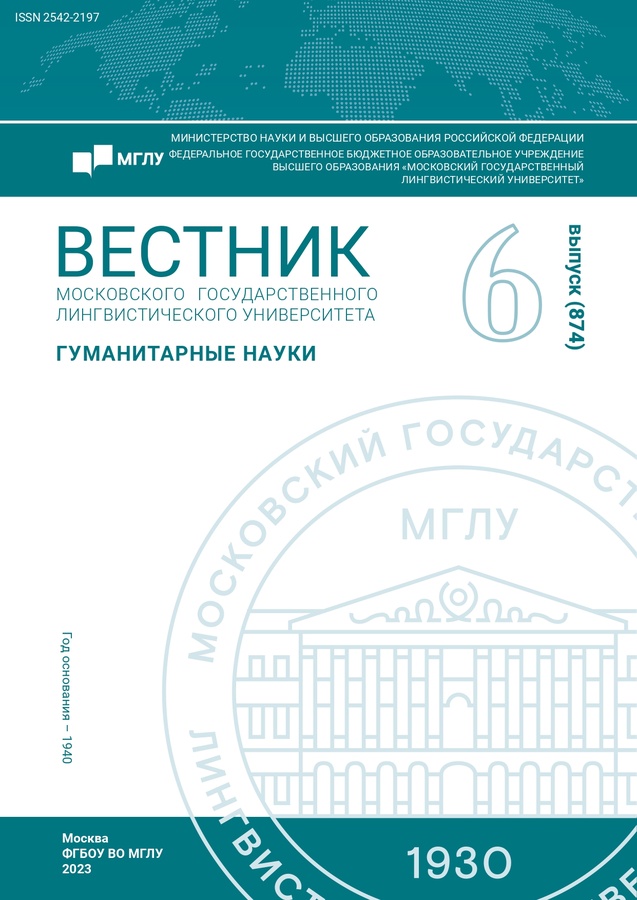Manifestation of Cognitive Load in Simultaneous Interpreting Using Adapters (based on the German language)
- Autores: Leonteva A.V.1,2, Agafonova O.V.1
-
Afiliações:
- Moscow State Linguistic University
- Institute of Linguistics of Russian Academy of Sciences
- Edição: Nº 6(874) (2023)
- Páginas: 94-100
- Seção: Linguistics
- URL: https://journal-vniispk.ru/2542-2197/article/view/351101
- ID: 351101
Citar
Texto integral
Resumo
The current research studies the increase in cognitive load and its manifestations on the verbal and non-verbal levels of speech during simultaneous interpreting from / into the native language. The results showed that an increase in cognitive load is manifested in speech difficulties, especially those associated with sound lengthening and slowing down the tempo, as well as in increased use of adapters.
Palavras-chave
Sobre autores
Anna Leonteva
Moscow State Linguistic University; Institute of Linguistics of Russian Academy of Sciences
Autor responsável pela correspondência
Email: lentevanja27@gmail.com
Researcher at the Center for Socio-Cognitive Discourse Studies (SCoDis), Senior Lecturer at the Department of English Phonetics Faculty of Moscow State Linguistic University; Junior Researcher at the Laboratory of Multi-Channel Communication, Institute of Linguistics of Russian Academy of Sciences
RússiaOlga Agafonova
Moscow State Linguistic University
Email: olga.agafonova92@gmail.com
Junior Researcher at the Center for Socio-Cognitive Discourse Studies (SCoDis), Senior Lecturer at the Department of Linguistics and Professional Communication in the Sphere of Media Technologies Institute of International Relations and Social and Political Sciences, Moscow State Linguistic University
RússiaBibliografia
- Sweller, J. (2016). Cognitive load theory, evolutionary educational psychology, and instructional design. Evolutionary perspectives on child development and education (pp. 291–306).
- Seeber, K. G. (2013). Cognitive load in simultaneous interpreting: Measures and methods. Target. International Journal of Translation Studies, 25(1), 18–32.
- Lederer, M. (1981). La traduction simultanée – expérience et théorie. Paris, France: Minard.
- Kendon, A. (2004). Gesture: Visible action as utterance. Cambridge University Press.
- McNeill, D. (1985). So you think gestures are nonverbal? Psychological review, 92(3), 350.
- Iriskhanova O. K., Cienki A. (2018). The Semiotics of Gestures in Cognitive Linguistics: Contribution and Challenges. Issues of Cognitive Linguistics, 4, 25–36.
- Müller, C. (2009). Metaphors dead and alive, sleeping and waking: A dynamic view. University of Chicago Press.
- Cienki, A., Mittelberg, I. (2013). Creativity in the forms and functions of spontaneous gestures with speech. Creativity and the Agile Mind, 231–252.
- Bressem, J. (2012). Repetitions in gesture: Structures, functions, and cognitive aspects. Faculty of Social and Cultural Sciences: European University Viadrina, Frankfurt (Oder). PhD Thesis.
- Cienki, A. (2017). Ten lectures on Spoken language and Gesture from Perspective of Cognitive Linguistics. Issues of Dynamicity and Multimodality. Leiden, Boston: Brill.
- Arbona, E., Seeber, K. G., Gullberg, M. (2023). Semantically related gestures facilitate language comprehension during simultaneous interpreting. Bilingualism: Language and Cognition, 26(2), 425–439.
- Mittelberg, I., Evola, V. (2014). Iconic and representational gestures. In Müller, C., Cienki, A. Fricke, E., Ladewig, S., McNeill, D., Bressem, J. (eds.), Handbücher zur Sprach- und Kommunikationswissenschaft = Handbooks of Linguistics and Communication Science (HSK), 38(2), 1732–1746. Berlin/Boston: De Gruyter Mouton.
- Clark, H. H. (1996). Using language. Cambridge University Press.
- Cienki, A. (2022). The study of gesture in cognitive linguistics: How it could inform and inspire other research in cognitive science. Wiley Interdisciplinary Reviews: Cognitive Science, 13(6), 1623.
- Kendon, A. (2017). Pragmatic functions of gestures: Some observations on the history of their study and their nature, Gesture, 16(2), 157–175.
- de la Iglesia, M. B., Opdenhoff, J. H. (2014). Retour interpreting revisited: Tuning competences in interpreter education. Journal of Consumer Research, 41(4), i-ii.
- Gumul, E. (2017). Explicitation and directionality in simultaneous interpreting. Linguistica Silesiana, 38, 311–329.
Arquivos suplementares










